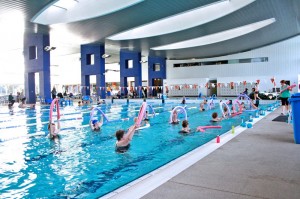Aqua Therapy: Recover, Get Fit and Have Fun
If you take a trip down to your local swimming pool during the week you are likely to stumble across an aqua aerobics class, where a bunch of over 60s are lunging and running on the spot in the pool. It may seem a bit silly (and fun) but exercising in water has some serious benefits.
Why Water is Wonderful – The Benefits
Aqua therapy or water exercise is popular amongst the elderly, injured or feeble as a low impact exercise which, can not only keep you fit, but help with rehabilitation needs.
When in a swimming pool our bodies have buoyancy and naturally want to float. Your relative body weight decreases hugely as it is supported by the water, meaning you can move with low impact. This allows you to build muscles through exercise without causing or furthering injury.
Swimming uses your whole body and therefore is a form of active stretching which can engage a full range of motion. Something other exercises may not offer.
If you have suffered an injury then aqua therapy and swimming can help you overcome it much more quickly and can provide an exercise alternative where previous methods are no longer an option.
Hydrostatic pressure is also a key component of water based exercise. When your body is submerged in the water, such as when floating, blood circulates much more effectively. As a consequence of this, swelling of lower extremities reduces, joint stress or pains can be relieved and tension headaches may be reduced.
As we mentioned in our cellulite fighting post, exercising in water is also an effective way to lose weight, the natural residence of the water makes exercise harder but will not take such a toll on the body.
As well as the many physical benefits, you may be surprised to know that aquatic therapy is also a great way of reducing mental stress. Many believe it can reduce anxiety, increase the ability to concentrate and improve confidence. Being in the water can be a calming influence, and with the pool atmosphere associated with fun, it can be a much more pleasant place than a sweaty gym.
Did You Know?
• The quicker you move in water the higher the resistance. Start slowly and gradually increase speed to build up your strength. Running in water is a favourite training exercise of athletes.
• The deeper you submerge your body the higher the resistance you feel.
• Water can help your balance.
• A flotation belt, arm bands or noodle may feel like they are helping you float, which they are, but they are also increasing the water resistance making it harder to move through the water.
• The resistance of water is 600 times more than that of air.
So will you be signing up to your nearest aqua aerobics class?
(image source: Local Fitness under CC BY-SA 3.0)
